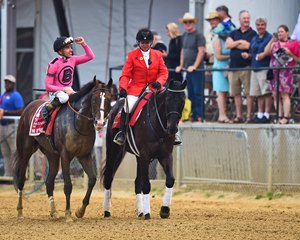War of Will Brings Attention to Stringhalt


Shortly after War of Will's Preakness Stakes (G1) victory May 18 at Pimlico Race Course, NBC footage made rounds on social media showing the 3-year-old walking back to the stable area while extending a hind leg.
Mark Casse dispelled concerns about the classic winner's soundness by explaining the colt has stringhalt, a condition that has given the trainer some concerns but has not stopped War of Will from reaching racing's heights.
"It kind of honestly just showed up one day where he started doing it. So we looked at him—we had vets examine him and everything," Casse said. "It's never been lameness. He's never been off on it. As crazy as it is, and when you see it sometimes, you're there with your mouth open. As I said about the first 150 times he did it, it scared me. It definitely comes when he's tired, it shows up a little more."
Dr. Stephanie Valberg, who directs the Equine Neuromuscular Diagnostic Laboratory in the Michigan State University Department of Large Animal Clinical Sciences, writes "stringhalt is characterized by a spasmodic and excessively rapid flexion of one or both hind limbs" and notes the movement is more noticeable when a horse is at a slower pace. For War of Will, his stringhalt has been seen at the walk, and Casse said the colt has never had an issue while performing on the track because of it.
There are two types of the condition—Australian stringhalt and classic stringhalt—Christa Lesté-Lasserre writes for The Horse. Australian stringhalt is caused by ingesting toxic plants and receives its name from veterinarians in Victoria, who described the condition in the late 1800s. False dandelion, or flatweed, has been found as a common plant to bring on the condition. Classic stringhalt has no apparent cause and more commonly affects only one leg.
Casse said War of Will's May 18 symptoms vanished shortly after the Preakness win.
"If they’re tired, they seem to do it a little more—or when they really exert themselves, like in a race or something," Casse said. "(War of Will) will do it a little more. He did it right after the race a little more, and then by the time, maybe 45 minutes later, when he got back to the barn, you would really have to look at it to even know it’s there."
Following the Preakness, Casse said an outrider told him War of Will’s stifle was locking up. But the trainer knew what the motion was, saying, "No, it's not. Believe me."
Casse said he has not experienced any problems with track veterinarians doing pre-race exams, which he credits to those professionals seeing his horse multiple times.
“The reason it’s never been an issue with the state veterinarians is, unlike most races, the Kentucky Derby and the Preakness and even the Breeders’ Cup, the state vets, they watch (the horses) train every day, so they get to see how great (War of Will) moves on the track," Casse said. "Where if somebody just came from just out of the blue and then looked at a horse, it would maybe be scarier to them than a veterinarian. But you’ll have a tough time seeing a horse travel better than ‘WOW’ does on the track.”
Surgery is one option to treat stringhalt, but Casse said he is hesitant to do that because the condition does not cause any problems for War of Will. Hagyard Equine Medical Institute also noted acupuncture can be used for stringhalt cases that cause lameness.
“Since it’s happened, I’ve had some horsemen give me their ideas about it and things that we could possibly do to help it or to change it,” Casse said. “But he travels so good and he performs so well, I don’t know if I want to change it.”
Plans call for War of Will to take aim at a second classic score in the June 8 Belmont Stakes Presented by NYRA Bets (G1) at Belmont Park.
